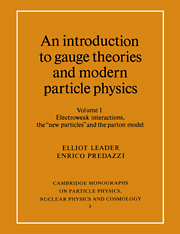Book contents
- Frontmatter
- Contents
- Preface
- Acknowledgements
- Notational conventions
- Note added in proof: the discovery of the top quark (?)
- Note added in proof: the demise of the SSC
- 1 Field theory and pre-gauge theory of weak interactions
- 2 The need for a gauge theory
- 3 Spontaneous symmetry breaking: the Goldstone theorem and the Higgs phenomenon
- 4 Construction of the standard model
- 5 Lowest order tests of the SM in the leptonic sector
- 6 The Higgs boson
- 7 The standard model beyond lowest order
- 8 e+e− physics and the standard model
- 9 Extension to the hadrons; quark–lepton universality
- 10 Phenomenology of semi-leptonic reactions
- 11 The discovery of the narrow vector resonances
- 12 Hidden flavour bound states
- 13 Open heavy flavours
- 14 The heavy lepton τ
- 15 Towards the parton model—deep inelastic scattering
- 16 The quark–parton model
- 17 Experimental tests of the quark-parton model
- Appendix 1 Elements of field theory
- Appendix 2 Feynman rules for QED, QCD and the SM
- Appendix 3 Conserved vector currents and their charges
- References
- Analytic subject index for vols. 1 and 2
8 - e+e− physics and the standard model
Published online by Cambridge University Press: 19 March 2010
- Frontmatter
- Contents
- Preface
- Acknowledgements
- Notational conventions
- Note added in proof: the discovery of the top quark (?)
- Note added in proof: the demise of the SSC
- 1 Field theory and pre-gauge theory of weak interactions
- 2 The need for a gauge theory
- 3 Spontaneous symmetry breaking: the Goldstone theorem and the Higgs phenomenon
- 4 Construction of the standard model
- 5 Lowest order tests of the SM in the leptonic sector
- 6 The Higgs boson
- 7 The standard model beyond lowest order
- 8 e+e− physics and the standard model
- 9 Extension to the hadrons; quark–lepton universality
- 10 Phenomenology of semi-leptonic reactions
- 11 The discovery of the narrow vector resonances
- 12 Hidden flavour bound states
- 13 Open heavy flavours
- 14 The heavy lepton τ
- 15 Towards the parton model—deep inelastic scattering
- 16 The quark–parton model
- 17 Experimental tests of the quark-parton model
- Appendix 1 Elements of field theory
- Appendix 2 Feynman rules for QED, QCD and the SM
- Appendix 3 Conserved vector currents and their charges
- References
- Analytic subject index for vols. 1 and 2
Summary
The recent story of narrow resonance discoveries (see Chapter 11) has shown how the properties of systems with quantum numbers of the photon (1−−) can best be studied with e+e- colliders. In this chapter we review some of the information that has come from e+e- machines. In particular, we shall see what support they provide for the SM. We also discuss the perspective for future e+e- colliders.
Electron-positron storage rings
The ideal tools for studying the spectroscopy of the new vector meson particles have undoubtedly been the various e+e- colliding beam machines: SPEAR at SLAC, DORIS at DESY (Deutsches Elektronen Synchrotron), PETRA at DESY and, more recently, SLC at Stanford and LEP 1 at CERN though the actual discovery (Aubert et al., 1974; Herb et al., 1977; UA1, 1983; UA2, 1983) of some of these particles occurred on the proton machines (Brookhaven, Fermilab and CERN).
The reason for the latter lies in the narrowness of these particles; one can simply miss them as one varies the energy. On the other hand, once discovered, the fact that J/Ψ(3097), ϒ(9.46) and the Z are vector particles 1––, and thus couple naturally to a virtual photon, makes an e+e- machine particularly efficacious since the main channel of e+e- annihilation is into a virtual photon.
Thus, it is rather difficult in an e+e- machine to sit right on top of one of these very narrow resonances whose width may be much smaller than the energy resolution of the machine itself.
- Type
- Chapter
- Information
- An Introduction to Gauge Theories and Modern Particle Physics , pp. 118 - 156Publisher: Cambridge University PressPrint publication year: 1996



